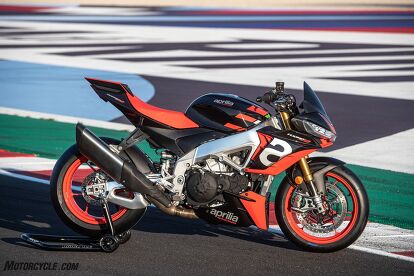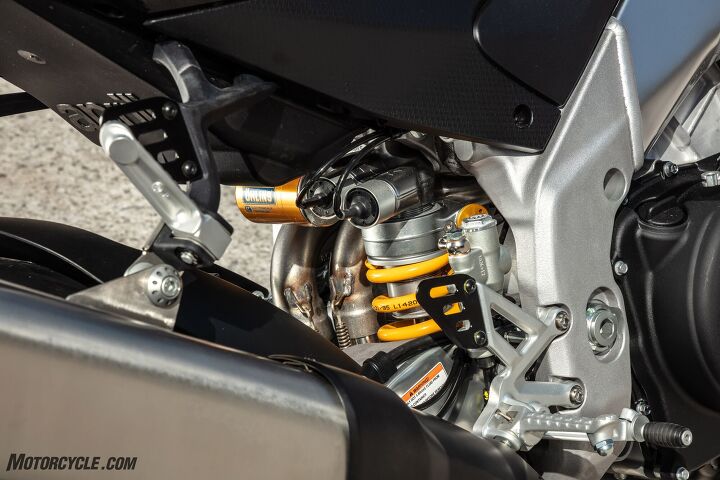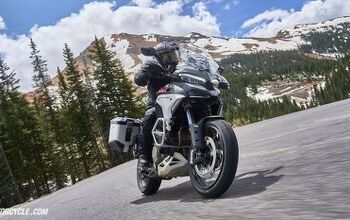2021 Aprilia Tuono V4 Review - First Ride

Further refinements to Aprilia's thunderous V4
Coming directly off of a six-bike shootout the previous day of paltry 900cc nekids, I knew I needed to focus on rewiring my brain to handle the beast that is the Aprilia Tuono V4. I’ve been a fan (and owner) of the Aprilia Tuono V4 platform for some time now – and I’m not the only one around here. From earning the editors’ top spot in our 2017 Supernaked Streetfighter Shootout!, to bringing home the people’s choice award in our Writer’s Choice: MO’s WSBK Sport-Touring Showdown in 2019, the Tuono’s list of accolades run deep through the years both at MO and other publications worldwide – and it just keeps getting better. With an ever more hard-edged category though, the Tuono hasn’t won them all.
2021 Aprilia Tuono V4 Factory
| Engine | 19.5/20 |
| Suspension/Handling | 14.5/15 |
| Transmission/Clutch | 9.0/10 |
| Brakes | 9.0/10 |
| Instruments/Controls | 4.25/5 |
| Ergonomics/Comfort | 9.0/10 |
| Appearance/Quality | 9.5/10 |
| Desirability | 9.5/10 |
| Value | 8.5/10 |
| Overall Score | 92.75/100 |
For 2021, we’re looking at incremental changes and a bit of differentiation in the position of the standard Tuono V4 versus the Tuono V4 Factory – now without double Rs and other confusing monikers to keep track of. The Tuono V4 is now more focused on being a street-friendly “hypernaked.” The base model has taller risers, a taller windscreen with slightly more wind protection around the front fairing, lower passenger pegs, a passenger grab rail, and a larger, more accommodating seat (similar to what has been seen before on previous Tuonos) with a more robust subframe for the potential extra weight of a passenger and luggage. The Factory model remains focused on outright performance with Öhlins SMART EC 2.0 electronic suspension, the RSV4-derived tail and subframe setup, and sportier rubber.
Incremental Changes
This has been the story of the Tuono V4 for some time. Not a lot of major overhauls throughout the V4’s lifespan. That’s not to say important changes didn’t happen, but rather that Aprilia put together a machine with such a solid foundation a decade ago(!), it’s only needed those incremental changes over the years to keep the V4 in fighting shape.
The 2021 1077 cc 65-degree V-Four now meets Euro 5 regulations, and thanks to the new Magneti Marelli 11MP ECU, we’re told the Tuono hasn’t lost any of its claimed 175 hp or 89 lb-ft of torque (at the crank). Equally important, the new ECU now allows for further refinement of the already stellar APRC electronics package which, in addition to the adjustable engine management, engine braking, traction control, wheelie control, launch control, and ABS, we’re told this has allowed Aprilia to further refine the electronic Öhlins suspension of the Factory model as well. All of these adjustments are easily made through a larger, five-inch TFT via the new left hand switchgear.
A new three-piece swingarm (originally made from seven welded components) that looks like an inverted version of what the machine was using previously is carried over from the latest RSV4 – an advancement trickled down from MotoGP racing and said to deliver 48% more stiffness at the rear axle. The Tuono Factory does not carry over the forged wheels of the RSV4 Factory model, though.
The redesigned fuel tank was reshaped to allow riders to better brace themselves with their lower body to take the weight off of the arms while remaining the same capacity at 4.9 gallons. Styling has also now been brought in line with the rest of the Tuono and RS families, including the integrated wings said to help dispel engine heat away from the rider, the new face including “bending” lights for illuminating corners, and a few new colors. The Tuono V4 is available in a matt Glacier White and Tarmac Grey while the Factory comes with one option: Aprilia Black. Pricing has increased to $15,999 for the V4 and $19,499 for the Factory.
Riding Impressions
For our ride the Factory models were set up as they would be off of the dealership floor while the Tuono V4s had accessory luggage racks with asymmetrical luggage and tank bags equipped to further illustrate the touring/commuting/streetability point that Aprilia was wanting to drive home. I’ve done all of that type of riding with my personal 2015 Aprilia Tuono V4 and never felt the need for much more than a backpack or tail bag. Sure, the taller risers of the ‘21 Tuono V4 raise you up a bit and make it a bit easier to have less weight on your wrists, but the lower bar of the Factory or my old bike has never presented much of an issue for me.
Prior to firing up the Tuono V4, Miguel Galluzzi, Head of Design at the Piaggio Advanced Design Center said something simple and poetic that stuck during our briefing. If I don’t say it in every story or review, I certainly think it while testing, “This is incredible, and I’m very fortunate.” Galuzzi brought up how important the Tuono has been for motorcycling and the naked motorcycle category (feel free to argue with him about what you think is a naked bike). For the engineering, design, and race teams to put together something that has held up so well from day one, and only needed the aforementioned incremental changes through the years while other models have come and gone, “That’s a very special moment in motorcycling history,” said Galuzzi calmly, “and today you’ll be riding the best version of it that there has ever been.”
Down on the street, the machines fired up with the operatic roar only a crew of Aprilia V4s can deliver. It sounds quieter and more refined than in the past, but every bit as willing as it once was. Before long we were tearing up into the mountains. On the Tuono V4, I was comfortably upright as we danced our way up into the mountains with the stable chassis allowing me to rail through the corners. The Sachs suspension and steering damper of the base model felt perfectly adept for our speed and terrain. After swapping on the Factory model, the lower bar was immediately noticeable, but for attacking corners, I preferred it. I left the electronic Öhlins suspension in the semi-active modes during our ride which handily soaked up the bumps along the way.
The amount of adjustability within the APRC suite is pretty incredible and way too much to try and test all of the different configurations during a single day’s ride. Plus, with the perfect riding conditions we had, it would take something really stupid to put those aids to the test. Like we covered with the RS660 and Tuono 660, the Tuono V4 has six ride modes: three for the street (one customizable) and three for the track (two customizable). On the Factory model, these modes also allow for adjustment of the suspension settings. The SMART EC 2.0 units can also be locked into a manual (rather than semi-active) mode to allow for more traditional suspension tweaking through the TFT display.
Keeping with the standard modes much of the day, I found the sportier AEM settings a bit abrupt for our bumpy canyon ride. At the track, I’m sure the sharper throttle response would be welcome. The semi-active suspension of the Factory model did an excellent job keeping things in shape no matter the compression bumps and broken pavement we encountered.
The Brembo M50s combined with the chassis are just as good as they ever were at slowing the machine down. At street speeds, you don’t really need anything more, but with so many machines sporting Stylemas these days, the M50s seem outdated. As for the extra rigidity of the new swingarm, I couldn’t tell you from just a street ride. Folks in our group who had sampled the RSV4 (complete with said swingarm) at the track mentioned that it was fantastic.
As we rolled back into town, we were reminded of the intense heat that a 1000 cc-plus V4 is capable of. After a few long consecutive red lights, one editor even threw his machine in neutral, put down the kickstand, and got off the bike for some relief. The heat didn’t seem any worse than before, and while riding, I only noticed a bit of heat at my right ankle – perhaps that new integrated fairing was working. Poking around town on a nearly 100-degree day however was, ahem, uncomfortable.
Final Thoughts
Largely the same machine that it once was, the Tuono V4 rips into 2021 with more sophisticated electronics, new styling, and the same stellar engine and chassis that we’ve come to expect from Noale. Differentiating the standard and Factory models makes sense. The bolt-on parts could be easily swapped in/out, you’ll just have to decide if the Öhlins bits are worth the $3,000 premium which of course comes down to what you plan on doing with the machine.
It’s still the exhilarating machine that made me plunk down my hard-earned dollars six years ago, but with all of the refinement I had hoped for plus some. Guess it’s time to add another shootout to our Naked Summer 2021 theme.
2021 Aprilia Tuono V4 and Tuono V4 Factory
+ Highs
- Refined electronics provide more adjustment and quicker computing
- Options are nice
- Long live the V4!
– Sighs
- MSRP keeps rising
- She puts out some heat at a standstill (so don’t stand still)
- Who said I had to come up with three?
In Gear

- Helmet: AGV K6
- Jacket: REV’IT! Stewart Air (discontinued)
- Pants: Pando Moto Steel Black Jeans (discontinued)
- Gloves: Racer Mickey
Boots: REAX Fulton Air
Specifications | 2021 Aprilia Tuono V4 Factory | 2021 Aprilia Tuono V4 |
|---|---|---|
| Engine type | 65° V-Four, four-strokes, liquid cooling system, double overhead camshaft (DOHC), four valves per cylinder | |
| Bore and stroke | 81.0 x 52.3 mm | |
| Total engine capacity | 1077 cc | |
| Horsepower | 175 hp at 11350 rpm (claimed) | |
| Torque | 89.2 lb-ft. at 9,000 rpm (claimed) | |
| Power Supply | Airbox with front dynamic air intakes. Four Weber-Marelli 48-mm throttle bodies with 4 injectors and latest generation Ride-by-Wire engine management that the rider can select on the fly | |
| Ignition | Magneti Marelli digital electronic ignition system integrated in engine control system, with one spark plug per cylinder and “stick-coil”-type coils | |
| Exhaust | 4 into 2 into 1 layout, two oxygen sensors, lateral single silencer with ECU-controlled bypass valve and ceramic matrix substrate catalytic converter (Euro 5). | |
| Alternator | Flywheel mounted 450 W alternator with rare earth magnets | |
| Lubrication | Wet sump lubrication system with oil radiator and two oil pumps (lubrication and cooling) | |
| Transmission | 6-speed cassette type gearbox. Gear lever with Aprilia Quick Shift electronic system (AQS) | |
| Clutch | Multiplate wet clutch with slipper system | |
| Drive | Chain; drive ratio: 42/15 | Chain; drive ratio: 40/15 |
| Traction management | APRC system (Aprilia Performance Ride Control) that includes engine maps (AEM), engine brake control (AEB), traction control (ATC), wheelie control (AWC), launch control (ALC), cruise control (ACC), speed limiter (APT). 6 riding modes (3 Road, 3 Track) | |
| Chassis | Aluminium dual beam chassis with pressed and cast sheet elements. Adjustments foreseen: position and angle of the headstock, engine height, swingarm pivot height. Upside-down double braced aluminium swingarm. | |
| Steering Damper | Smart EC 2.0 electronically managed Öhlins steering damper | Sachs steering damper |
| Front Suspension | Smart EC 2.0 electronically managed Öhlins NIX fork with TIN surface treatment. Completely adjustable spring preload and hydraulic compression and rebound damping. | Sachs fully adjustable single shock absorber. |
| Front Wheel Travel | 4.7 inches | 4.6 inches |
| Rear Suspension | Smart EC 2.0 electronically managed Öhlins monoshock absorber with piggy-back. APS progressive linkages. | Sachs monoshock absorber with piggy-back, fully adjustable in: spring preload, hydraulic compression and rebound damping. |
| Rear Wheel Travel | 5.1 inches | |
| Front Brakes | Dual 330-mm diameter floating stainless steel disc with lightweight stainless steel rotor with 6 pins. Brembo M50 monobloc radial callipers with 4 Ø30mm opposing pistons. Sintered pads. Radial pump and metal braided brake lines. | |
| Rear Brakes | 220 mm diameter disc; Brembo floating calliper with two 32-mm Ø isolated pistons. Sintered pads. Master cylinder with built in reservoir and metal braided hose. | |
| ABS | Bosch 9.1 MP ABS with cornering function, adjustable on 3 maps, featuring RLM strategy and can be disengaged. | |
| Front Wheel | 3.5”x17” cast aluminum wheels with 3 split spoke design. | |
| Rear Wheel | 6.00”x17” cast aluminum wheels with 3 split spoke design. | |
| Front Tire | 120/70 ZR 17, radial tubeless | |
| Rear Tire | 200/55 ZR 17 (alternative: 190/50 ZR 17;), radial tubeless | 190/55 ZR 17, radial tubeless |
| Wheelbase | 57.1 inches | |
| Length | 81.5 inches | |
| Width | 31.9 inches | |
| Seat Height | 32.5 inches | |
| Rake/Trail | 24.7°/3.9 inches | |
| Dry weight | 407.9 pounds (claimed) | |
| Curb weight | 471 pounds (measured) | |
| CO2 emissions | 170 g/km | |
| Fuel tank capacity | 4.9 gallons (1.1 gallons reserve) | |
| Fuel Economy | 32.7 mpg (claimed) | |
We are committed to finding, researching, and recommending the best products. We earn commissions from purchases you make using the retail links in our product reviews. Learn more about how this works.
Become a Motorcycle.com insider. Get the latest motorcycle news first by subscribing to our newsletter here.

Ryan’s time in the motorcycle industry has revolved around sales and marketing prior to landing a gig at Motorcycle.com. An avid motorcyclist, interested in all shapes, sizes, and colors of motorized two-wheeled vehicles, Ryan brings a young, passionate enthusiasm to the digital pages of MO.
More by Ryan Adams







































































































































































































































































Comments
Join the conversation
The 3rd negative is the fuel economy.
But yeah, I love Tuonos.
Is this the (high)HP/$ king of the world?